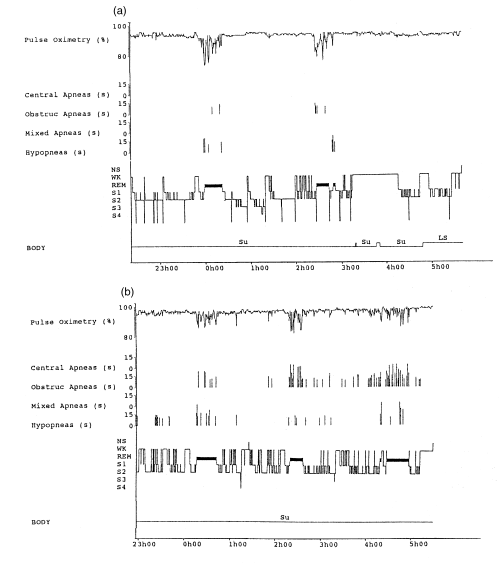Rapid eye movement-localized apnea in a female patient with chronic insomnia
Abstract
A middle-aged female patient with chronic insomnia showed rapid eye movement (REM)- localized obstructive sleep apnea. She visited the Sleep Disorders Clinic and complained of insomnia with loud snoring. Once, in the past, her sleep complaints had disappeared after weight reduction but, 6 months later, she complained of excessive daytime sleepiness. Overnight polysomnography revealed REM-localized apnea. Careful follow up is strongly recommended for a female patient with chronic insomnia who shows REM-localized apnea.
INTRODUCTION
Obstructive sleep apnea syndrome (OSAS) is not rare in postmenopausal females. According to the International Classification of Sleep Disorders (ICSD), OSAS is defined as occurring more than five times per hour with arousal responses occurring not only during rapid eye movement (REM) but also during non-REM, with habitual snoring, excessive daytime sleepiness (EDS), and dry mouth upon awakening.1 However, it has long been considered that apneas that occur only during REM were not pathological.2 Another point of view suggests that REM is the most vulnerable stage of OSAS.
PATIENT AND CLINICAL COURSE
A 49-year-old woman visited the Sleep Disorders Clinic complaining of habitual loud snoring, morning headache and dry mouth upon awakening. She had undergone menopause at age 41 years after an operation for endometriosis. Her body mass index (BMI) was 31.8 and the first overnight polysomnography (PSG) revealed REM-localized apnea. Weight reduction improved her sleep complaints. Six months later, when her BMI increased to 29.2, she began to complain of mid-sleep awakening and EDS. At that time her Epworth sleepiness score was 17. With PSG, her respiratory disturbance index was 20.9 and arousal index was 21.1; hence, she was diagnosed as suffering from moderate OSAS.
RESULTS
Figure 1 shows the PSG findings using an Alice3 (HealthdyneTM; Atlanta, USA). The patient had first visited the Sleep Disorders Clinic at age 45 years complaining of chronic insomnia. A PSG revealed REM-localized apnea with oxygen desaturation (Fig. 1a). But her sleep disturbances worsened when her weight increased. Finally, she began to suffer from moderate OSAS (Fig. 1b).

. Graphic summary of overnight polysomnography. Oxygen saturation using pulse oximeter (SpO2), Central sleep apnea (CSA), obstructive sleep apnea (OSA), mixed sleep apnea (MSA), hypopnea are shown in vertical bars. Hypnogram with stages of wakefulness, rapid eye movement (REM) sleep and non-REM sleep (stages 1–4). Body position is shown in horizontal line. Su, supine position; LS, lateral position to left side. Note that apneas and hypopneas occur almost exclusively during REM sleep. (a) REM-localized apnea with oxygen desaturation. The 45-year-old patient had a body mass index (BMI) of 31.8, Epworth sleep scale (ESS) of 7, her RDI was 2.6 and her arousal index was 8.7. Sleep efficiency index was 0.735 and percent time of SpO2 below 90% was 3%. (b) Moderate OSAS. The 48-year-old patient had a BMI of 29.2, ESS of 17, an RDI of 20.9 and an arousal index of 21.1 while measured in a supine position throughout the recording. Sleep efficiency index was 0.76 and percent time of SpO2 below 90% was 1%.
DISCUSSION
Gulliminault et al. have evaluated REM-localized apneas as not being pathological.2 Conversely, Lugaresi and colleagues have proposed a continuum concept from simple snoring to severe OSAS as heavy snorers’ disease.3 Recently, the new concept of REM OSA was proposed, which occur predominantly in females.4 This is the first case of REM-localized apnea in Japan. Esophageal pressure should be monitored in this patient so as to differentiate her condition from upper airway resistance syndrome.




